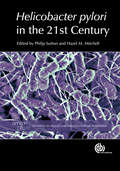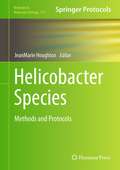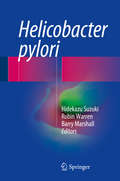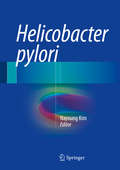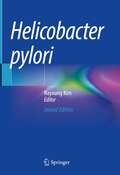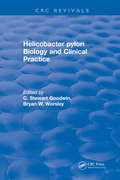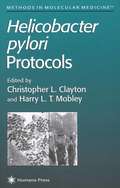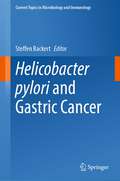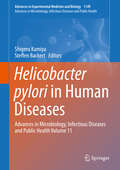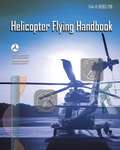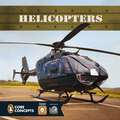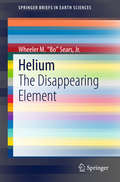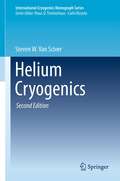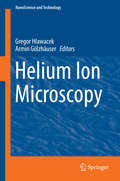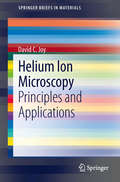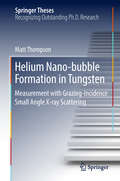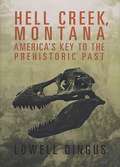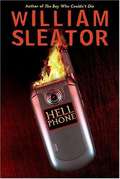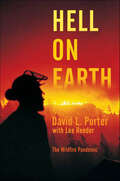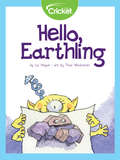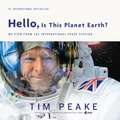- Table View
- List View
Helicobacter Pylori in the 21st Century
by Philip Sutton Hazel M. MitchellBiomedical researchers from Australia, the US, Europe, and Japan review the current status of knowledge about the spiral bacteria, its infection of the human gastric system, and the disease it causes there. In sections on pathologies and treatment, host response, and bacterial mechanisms of pathogenesis, they consider such topics as the epidemiology, antimicrobial resistance and approaches to treatment, host genetic factors in susceptibility and resistance to H. pylori pathogenesis, vaccines, virulence factors, and adhesion to the gastric surface.
Helicobacter Species
by Jeanmarie HoughtonIdentifying Helicobacter infection as the leading cause of peptic ulcer disease and gastric cancer has dramatically altered the treatment of these disease states. Over the last several decades, scientists have come to understand that the interplay between the bacteria, the host, and the environment all contribute to the clinical outcome of infection. In Helicobacter Species: Methods and Protocols, expert researchers in the field detail many of the methods and which are now commonly used to study Helicobacter infection. These include protocols and methods that have evolved over time, and standards across the field have been established which are essential for optimal outcomes and to allow comparison of data across different laboratories. Written in the highly successful Methods in Molecular BiologyTM series format, chapters include introductions to their respective topics, lists of the necessary materials and reagents, step-by-step, readily reproducible laboratory protocols, and key tips on troubleshooting and avoiding known pitfalls. Authoritative and practical, Helicobacter Species: Methods and Protocols seeks to aid scientists in further study of this crucially important research into Helicobacter research.
Helicobacter pylori
by Hidekazu Suzuki Robin Warren Barry MarshallThis book provides a detailed review of the most recent pathogenetic, diagnostic and therapeutic approaches in connection with Helicobacter pylori, along with priority areas in research and trends in clinical practice to address this significant pathogen acknowledged as the causative agent in a wide range of diseases, including gastric adenocarcinoma, MALT lymphoma and immune thrombocytopenic purpura (ITP). Medical authorities worldwide now recommend a "test and treat" strategy for this bacterial infection. Eradication therapy approaches range from general mass eradication therapy to tailor-made therapy for antibiotic-resistant refractory infection. In regions with high prevalence of H. pylori infection, the infection itself would be considered a major parameter to predict the risk of gastric adenocarcinoma development. The main interest has shifted recently to the risk stratification strategy for gastric cancer development and to the wide-ranging application of its serological prevention program. This book will benefit all gastroenterologists, hematologists, dermatologists, primary care doctors, epidemiologists, physicians who related with community hygiene, as well as basic scientists, particularly microbiologists, bacteriologists, pathologists, molecular biologists, biochemists, immunologists and oncologists.
Helicobacter pylori
by Nayoung KimThis book presents thecurrent state of knowledge regarding the ability of Helicobacter pylori to colonize the gastrointestinal tract, theglobal epidemiology of H. pyloriinfection, transmission routes, the pathophysiology of H. pylori-related gastroduodenal and other diseases, diagnosis andtreatment methods, guidelines for eradication, antibiotic resistance, thereinfection rate after H. pylori eradication,and animal models of H. pylori orrelated Helicobacter infection. Theaim is to equip readers around the world with the understanding required inorder to implement effective methods of H. pylori eradication and to enhance clinical outcomes for patients. The textis clearly written and is complemented by many helpful illustrations. This bookwill be a great asset in clinical practice for all practitioners who areinvolved in caring for patients with H. pylori-related diseases or have an interest in the subject. It will also bea useful source of information for medical students and for intelligent laypeopleseeking information on H. pylori.
Helicobacter pylori
by Nayoung KimThis book presents the current state of knowledge regarding the ability of Helicobacter pylori to colonize the gastrointestinal tract, the global epidemiology of H. pylori infection, transmission routes, the pathophysiology of H. pylori-related gastroduodenal and other diseases, diagnosis and treatment methods, guidelines for eradication, antibiotic resistance, the reinfection and recrudescence rate after H. pylori eradication, the effect of H. pylori and its eradication on the gastric microbiota and animal models of H. pylori or related Helicobacter infection. The aim is to equip readers around the world with the understanding required in order to implement effective methods of H. pylori eradication and to enhance clinical outcomes for patients. In addition, readers can understand the interaction between H. pylori and other gut microbiota during chronic infection and after H. pylori eradication. The text is clearly written and is complemented by many helpful illustrations. This book will be a great asset in clinical practice for all practitioners who are involved in caring for patients with H. pylori-related diseases or have an interest in the subject. It will also be a useful source of information for medical students and for intelligent laypeople seeking information on H. pylori.
Helicobacter pylori Biology and Clinical Practice: Biology And Clinical Practice
by C. Stewart GoodwinHelicobacter pylori: Biology and Clinical Practice is the first book to fully describe H. pylori and the pathogenesis of H. pylori infections. It delineates the genome of H. pylori, discusses the molecular biology of the unique urease enzyme, and examines the clinical application of these discoveries. The book describes the epidemiology of H. pylori and its relevance to gastric cancer, and it offers clear guidance to clinicians for the diagnosis and treatment of peptic ulcer and non-ulcer dyspepsia in adults and children. Vaccine principles and possibilities are presented for the first time. Edited by the leader of the microbiology team that achieved the first culture of H. pylori, and named the Helicobacter genus, this book is essential for bacteriologists, gastroenterologists, microbiologists, infectious disease specialists, and other researchers interested in H. pylori.
Helicobacter pylori Protocols
by Christopher L. Clayton Harry L. MobleyHelicobacter pylori Protocols offers an outstanding collection of state-of-the-art protocols for the identification and molecular manipulation of H. pylori. The authoritative contributors supply detailed and readily reproducible protocols for the culturing of H. pylori, for the isolation and restriction endonuclease digestion of H. pylori chromosomal DNA, and for the transformation and insertional mutagenesis of H. pylori. They also provide molecular epidemiological techniques, including ribotyping, PCR-RFLP, and RAPD-PCR. These procedures have been developed by leading practitioners to solve the difficult technical problems created by the application of the powerful bacterial genetic and molecular cloning techniques to H. pylori.
Helicobacter pylori and Gastric Cancer (Current Topics in Microbiology and Immunology #444)
by Steffen BackertThis volume explores in detail the molecular biology, genetics and immunology of the bacterium Helicobacter pylori that causes serious gastric diseases such as gastric cancer. The book provides in-depth insights into the mechanisms of H. pylori-induced pathogenicity, gives an overview of how the bacterium colonizes the human gut, how it manages to persist in the body and which factors play a role in the development of H. pylori-induced gastric cancer. Furthermore, the interaction between the Gram-negative bacterium and the human gut microbiome is explored, and clinical management and treatment strategies to combat gastric cancer are discussed.Helicobacter pylori is an extremely successful pathogen that persistently colonizes the gut of about 50% of the world’s population. H. pylori and its human host share a long co-evolutionary relationship that dates back for at least last 100,000 years and possibly longer. Infection by this bacterium is a high-risk factor for the development of gastric diseases, including gastric cancer. Gastric cancer is associated with high morbidity and mortality and represents the 5th most common malignant tumour and the 4th leading cause of cancer-related death worldwide. H. pylori is the first bacterium that has been classified as a type-I carcinogen by the International Agency for Research on Cancer (IARC). Recent research progress identified crucial bacterial, host and environmental factors which control H. pylori-induced gastric malignancy. New studies also suggest that specific human germline mutations and other genetic aberrations have an important impact on H. pylori-induced pathology. In this volume, all these recently discovered mechanisms are reviewed in the light of gastric cancer development, and H. pylori epidemiology, virulence factors, immune evasion, pathophysiology, cancer signalling and novel therapeutic protocols are presented. This volume is aimed at researchers in the fields of immunology, genetics, microbiology and medicine who are interested in the detailed mechanisms of the pathogenicity of this carcinogenic stomach bacterium.
Helicobacter pylori in Human Diseases: Advances in Microbiology, Infectious Diseases and Public Health Volume 11 (Advances in Experimental Medicine and Biology #1149)
by Steffen Backert Shigeru KamiyaThis book gathers a wealth of contributions on the virulence factors and pathogenic mechanism of Helicobacter pylori, prepared by leading international experts. In addition, it explores the epidemiology, diagnosis, treatment with drugs and probiotics, and prophylaxis by vaccination, reflecting the latest advances. H. pylori is a Gram negative microaerophilic bacterium that can produce various gastric diseases including gastritis, gastroduodenal ulceration, gastric cancer and gastric MALT lymphoma. Although efforts to combat H. pylori using a combination of proton pump inhibitor and several antimicrobial drugs have significantly decreased the burden of these gastric diseases, the microbial epidemiology and gastric pathogenesis following H. pylori infection are still not fully understood. Given its scope, the book offers a valuable resource not only for basic microbiologists, but also for researchers in the fields of pathology, biochemistry and genomics, as well as medical students/scientists.
Helicopter Flying Handbook: FAA-H-8083-21B (Asa Faa Handbook Ser.)
by Federal Aviation AdministrationAn official publication of the Federal Aviation Administration, this is the ultimate technical manual for anyone who flies or wants to learn to fly a helicopter.If you&’re preparing for private, commercial, or flight instruction pilot certificates, it&’s more than essential reading—it&’s the best possible study guide available, and its information can be lifesaving. In authoritative and easy-to-understand language, here are explanations of general aerodynamics and the aerodynamics of flight, navigation, communication, flight controls, flight maneuvers, emergencies, and more.Also included is an extensive glossary of terms ensuring that even the most technical language can be easily understood. Helicopter Flying Handbook is an indispensable text for any pilot who wants to operate a helicopter safely in a range of conditions. Chapters cover a variety of subjects including helicopter components, weight and balance, basic flight maneuvers, advanced flight maneuvers, emergencies and hazards, aeronautical decision making, night operations, and many more. With full-color illustrations detailing every chapter, this is a one-of-a-kind resource for pilots and would-be pilots.
Helicopters (Penguin Core Concepts)
by Nick Confalone Chelsea ConfaloneHelicopters are amazing machines. They can take off and land vertically, hover over an area, and fly forward, backward, and laterally. This new nonfiction 8x8 is full of fascinating facts and photographs of these incredible choppers.
Heliophysics
by Carolus J. Schrijver George L. SiscoeHeliophysics is a fast-developing discipline that integrates studies of the Sun's variability, the surrounding heliosphere, and the environment and climate of planets. Over the past few centuries, our understanding of how the Sun drives space weather and climate on the Earth and other planets has advanced dramatically. This set, first published in hardback in 2009 and 2010, brings together three books edited by Carolus Schrijver and George Siscoe, which together provide a complete guide to heliophysics - covering the full range of sub-disciplines that constitute this field. Supplemented by online teaching materials, the volumes can be used as textbooks for graduate courses or as a foundational reference resource for researchers in fields from astrophysics and plasma physics to planetary and atmospheric science. Volume 1 is Heliophysics: Plasma Physics of the Local Cosmos, Volume 2 is Heliophysics: Space Storms and Radiation: Causes and Effects, and Volume 3 is called Heliophysics: Evolving Solar Activity and the Climates of Space and Earth.
Heliophysics
by Carolus J. Schrijver Frances Bagenal Jan J. SojkaHeliophysics is a fast-developing discipline that integrates studies of the Sun's variability, the surrounding heliosphere, and the environment and climate of planets. Over the past few centuries, our understanding of how the Sun drives space weather and climate on the Earth and other planets has advanced dramatically. This set brings together three books edited by Carolus Schrijver and George Siscoe, which together provide a complete guide to heliophysics - covering the full range of sub-disciplines that constitute this field. Supplemented by online teaching materials, the volumes can be used as textbooks for graduate courses or as a foundational reference resource for researchers in fields from astrophysics and plasma physics to planetary and atmospheric science. Volume 1 is Heliophysics: Plasma Physics of the Local Cosmos, Volume 2 is Heliophysics: Space Storms and Radiation: Causes and Effects, and Volume 3 is called Heliophysics: Evolving Solar Activity and the Climates of Space and Earth.
Heliophysics: Evolving Solar Activity and the Climates of Space and Earth
by Carolus J. Schrijver George L. SiscoeHeliophysics is a fast-developing scientific discipline that integrates studies of the Sun's variability, the surrounding heliosphere, and the environment and climate of planets. Over the past few centuries, our understanding of how the Sun drives space weather and climate on the Earth and other planets has advanced at an ever increasing rate. This 2010 volume, the last in this series of three heliophysics texts, focuses on long-term variability from the Sun's decade-long sunspot cycle and considers the evolution of the planetary system over ten billion years from a climatological perspective. Topics covered range from the dynamo action of stars and planets to processes in the Earth's troposphere, ionosphere, and magnetosphere and their effects on planetary climate and habitability. Supplemented by online teaching materials, it can be used as a textbook for courses or as a foundational reference for researchers in fields from astrophysics and plasma physics to planetary and climate science.
Heliophysics: Plasma Physics of the Local Cosmos
by Carolus J. Schrijver George L. SiscoeHeliophysics is a developing scientific discipline integrating studies of the Sun's variability, the surrounding heliosphere, and climatic environments. Over the past few centuries, our understanding of how the Sun drives space weather and climate on the Earth and other planets has advanced at an ever-increasing rate. This 2009 volume, the first in this series of three heliophysics texts, integrates such diverse topics for the first time as a coherent intellectual discipline. It emphasises the physical processes coupling the Sun and Earth, allowing insights into the interaction of the solar wind and radiation with the Earth's magnetic field, atmosphere and climate system. It provides a core resource for advanced undergraduates and graduates, and also constitutes a foundational reference for researchers in heliophysics, astrophysics, plasma physics, space physics, solar physics, aeronomy, space weather, planetary science and climate science. Additional online resources, including lecture presentations and other teaching materials, are accessible at www. cambridge. org/9780521110617.
Helium
by Jr. Wheeler M. "Bo" SearsThe subject of the book is helium, the element, and its use in myriad applications including MRI machines, particle accelerators, space telescopes, and of course balloons and blimps. It was at the birth of our Universe, or the Big Bang, where the majority of cosmic helium was created; and stellar helium production continues. Although helium is the second most abundant element in the Universe, it is actually quite rare here on Earth and only exists because of radioactive elements deep within the Earth. This book includes a detailed history of the discovery of helium, of the commercial industry built around it, how the helium we actually encounter is produced within the Earth, and the state of the helium industry today. The gas that most people associate with birthday party balloons is running out. "Who cares?" you might ask. Well, without helium, MRI machines could not function, rockets could not go into space, particle accelerators such as those used by CERN could not operate, fiber optic cables would not exist, and semiconductor chips could not be made. . . the list goes on and on.
Helium Cryogenics
by Steven W. Van SciverTwenty five years have elapsed since the original publication of Helium Cryogenics. During this time, a considerable amount of research and development involving helium fluids has been carried out culminating in several large-scale projects. Furthermore, the field has matured through these efforts so that there is now a broad engineering base to assist the development of future projects. Helium Cryogenics, 2nd edition brings these advances in helium cryogenics together in an updated form. As in the original edition, the author's approach is to survey the field of cryogenics with emphasis on helium fluids. This approach is more specialized and fundamental than that contained in other cryogenics books, which treat the associated range of cryogenic fluids. As a result, the level of treatment is more advanced and assumes a certain knowledge of fundamental engineering and physics principles, including some quantum mechanics. The goal throughout the work is to bridge the gap between the physics and engineering aspects of helium fluids to provide a source for engineers and scientists to enhance their usefulness in low-temperature systems. Dr. Van Sciver is a Distinguished Research Professor and John H. Gorrie Professor of Mechanical Engineering at Florida State University. He is also a Program Director at the National High Magnetic Field Laboratory (NHMFL). Dr. Van Sciver joined the FAMU-FSU College of Engineering and the NHMFL in 1991, initiating and teaching a graduate program in magnet and materials engineering and in cryogenic thermal sciences and heat transfer. He also led the NHMFL development efforts of the cryogenic systems for the NHMFL Hybrid and 900 MHz NMR superconducting magnets. Between 1997 and 2003, he served as Director of Magnet Science and Technology at the NHMFL. Dr. Van Sciver is a Fellow of the ASME and the Cryogenic Society of America and American Editor for the journal Cryogenics. He is the 2010 recipient of the Kurt Mendelssohn Award. Prior to joining Florida State University, Dr. Van Sciver was Research Scientist and then Professor of Nuclear Engineering, Engineering Physics and Mechanical Engineering at the University of Wisconsin-Madison from 1976 to 1991. During that time he also served as the Associate Director of the Applied Superconductivity Center. Dr. Van Sciver received his PhD in Low Temperature Physics from the University of Washington-Seattle in 1976. He received his BS degree in Engineering Physics from Lehigh University in 1970. Dr. Van Sciver is author of over 200 publications and patents in low temperature physics, liquid helium technology, cryogenic engineering and magnet technology. The first edition of Helium Cryogenics was published by Plenum Press (1986). The present work is an update and expansion of that original project.
Helium Ion Microscopy
by Gregor Hlawacek Armin GölzhäuserThis book covers the fundamentals of Helium Ion Microscopy (HIM) including the Gas Field Ion Source (GFIS), column and contrast formation. It also provides first hand information on nanofabrication and high resolution imaging. Relevant theoretical models and the existing simulation approaches are discussed in an extra section. The structure of the book allows the novice to get acquainted with the specifics of the technique needed to understand the more applied chapters in the second half of the volume. The expert reader will find a complete reference of the technique covering all important applications in several chapters written by the leading experts in the field. This includes imaging of biological samples, resist and precursor based nanofabrication, applications in semiconductor industry, using Helium as well as Neon and many more. The fundamental part allows the regular HIM user to deepen his understanding of the method. A final chapter by Bill Ward, one of the pioneers of HIM, covering the historical developments leading to the existing tool complements the content.
Helium Ion Microscopy
by David C. JoyHelium Ion Microscopy: Principles and Applications describes the theory and discusses the practical details of why scanning microscopes using beams of light ions - such as the Helium Ion Microscope (HIM) - are destined to become the imaging tools of choice for the 21st century. Topics covered include the principles, operation, and performance of the Gaseous Field Ion Source (GFIS), and a comparison of the optics of ion and electron beam microscopes including their operating conditions, resolution, and signal-to-noise performance. The physical principles of Ion-Induced Secondary Electron (iSE) generation by ions are discussed, and an extensive database of iSE yields for many elements and compounds as a function of incident ion species and its energy is included. Beam damage and charging are frequently outcomes of ion beam irradiation, and techniques to minimize such problems are presented. In addition to imaging, ions beams can be used for the controlled deposition, or removal, of selected materials with nanometer precision. The techniques and conditions required for nanofabrication are discussed and demonstrated. Finally, the problem of performing chemical microanalysis with ion beams is considered. Low energy ions cannot generate X-ray emissions, so alternative techniques such as Rutherford Backscatter Imaging (RBI) or Secondary Ion Mass Spectrometry (SIMS) are examined.
Helium Nano-bubble Formation in Tungsten: Measurement With Grazing-incidence Small Angle X-ray Scattering (Springer Theses)
by Matt ThompsonThis PhD thesis characterises the damage that occurs in tungsten when it is exposed to a fusion-like environment. The book presents pioneering work on the use of grazing-incidence small-angle X-ray scattering (GISAXS) to measure nano-bubble formation in tungsten exposed to helium plasma. The phenomenon of nanoscale bubble formation within metals during helium plasma exposure can lead to undesirable changes in the material properties, such as complex nanoscale surface modification or a reduction in thermal conductivity. As a result of this work, it is now possible to quantify how nanobubble behaviour changes within different materials, and under different plasma conditions. In 2015 the author published the first GISAXS study of helium-induced nanobubble formation in tungsten, demonstrating the viability of using GISAXS for this work. This paper has generated significant interest from the international fusion community and was selected as one of the highlights for the journal Nuclear Fusion.
Hell Creek, Montana
by Lowell DingusHell Creek, Montana, is one of the most windswept, hardscrabble locales in the American West-a quiet town of ranchers, farmers, and others who seek the beauty of the open spaces. It is also the unlikely setting of some of the most fascinating events in the history of the United States and North America. From the first-ever discovery of a Tyrannosaurus rex to Lewis and Clark's landmark expedition; from the Freeman compound standoff to Sitting Bull and Little Big Horn, Hell Creek has been a central player in the events of the last two hundred years-and the last 200 million.Now, with grace and quiet wit, renowned paleontologist and writer Lowell Dingus takes us on a tour of this desolate, beautiful, out-of-the-way place and illuminates its inhabitants, geology, paleontology, and surprising place in history. Nature lovers, dinosaur buffs, and people fascinated with the turbulent history--both ancient and modern--of the American West will find much to delight them in this journey to Hell Creek.
Hell Phone
by William SleatorNick wants a cell phone for talking to his girlfriend. Little does he know that a used cheap phone, puts him at risk for himself, and those he cares about.
Hell on Earth: The Wildfire Pandemic
by David L. Porter Lee ReederThe world is burning, and it appears that we are to blame. Conditions that create large-scale fire disasters are occurring more frequently every year, spurred on by global warming. And the potential for damage, loss of life, and greater harm to the environment is staggering.As devastating fires increase throughout the western and southern United States, the number of fires in the Brazilian rain forest continues to increase as well. Vast areas of the wilderness are dying throughout the West, setting the stage for a human and environmental tragedy.David L. Porter has been covering wild fires in the west for more than twelve years. After losing his home to a wildfire in 2003, he set out to find how and why this was happening, not only in the western US, but around the world. Hell on Earth chronicles the origins of these catastrophes as well as the effects they are having on our planet.At the Publisher's request, this title is being sold without Digital Rights Management Software (DRM) applied.
Hello, Earthling
by Liz HuyckAstronomers have discovered a distant planet that can possibly sustain life. The planet is known as Earth and is inhabited by humans! Children will enjoy seeing how aliens might imagine the shapes and colors of Earth's creatures.
Hello, Is This Planet Earth?: My View from the International Space Station
by Tim PeakeThe #1 international bestseller: An astronaut's tour of our planet from the heavens, featuring 150 mesmerizing photographs (with commentary) from the International Space Station During his six-month mission to the International Space Station, astronaut Tim Peake became the first British astronaut to complete a spacewalk--and, perhaps more astonishingly, the first to run an entire marathon in space. During his historic mission, he captured hundreds of dazzling photographs, the very best of which are collected here.Tim captures the majesty of the cosmos and of the planet we call home: breath-taking aerial photos of the world's cities illuminated at night, the natural beauty of the northern lights, and unforgettable views of oceans, mountains, and deserts.Tim's lively stories about life in space appear alongside these photographs, including the tale from which the title is taken: his famous wrong number dialed from space, when he accidentally called a stranger and asked: "Hello, is this planet Earth?" With this truly unique perspective on the incredible sights of our planet, Tim demonstrates that while in space, hundreds of miles above his friends and family, he never felt closer to home.
